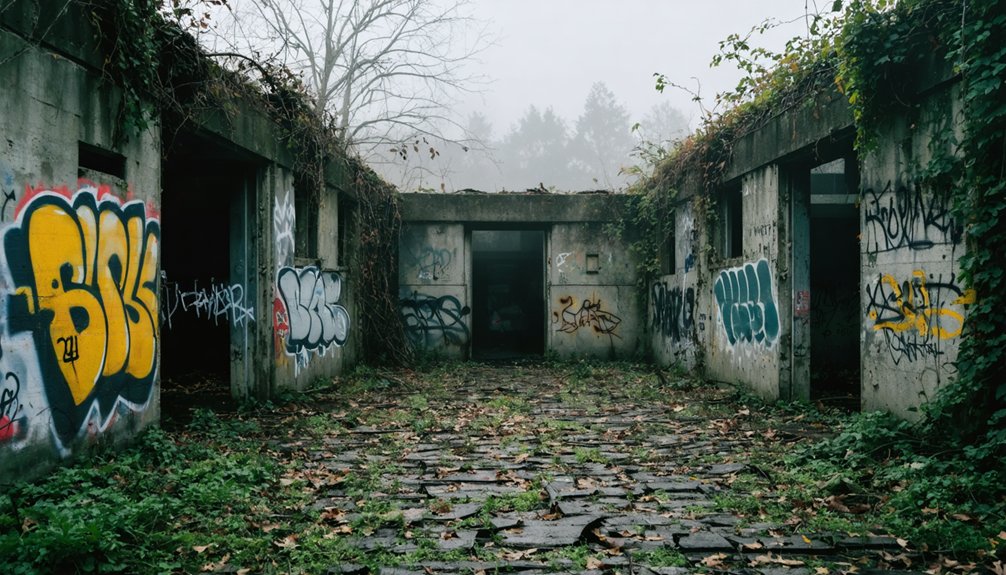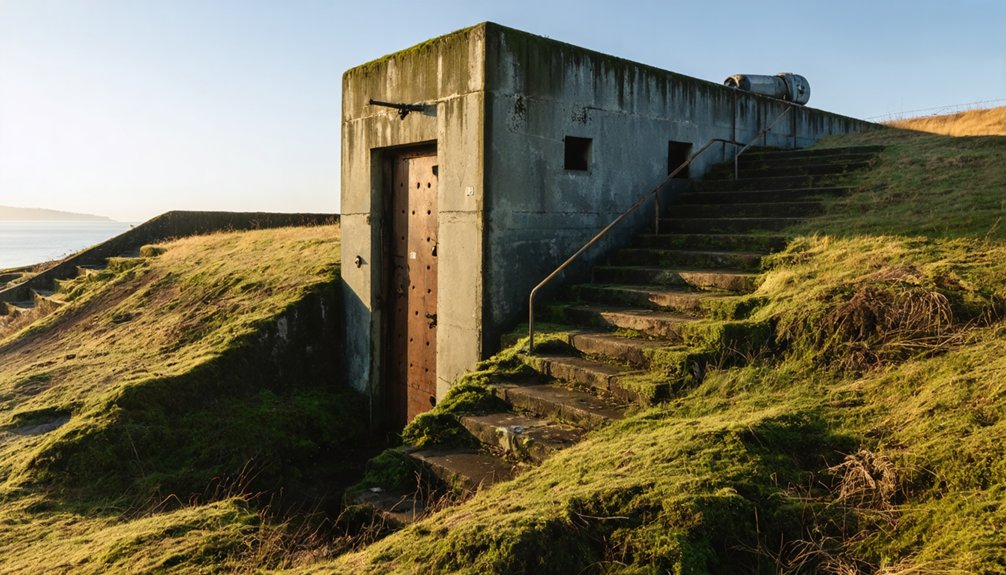You’ll discover fascinating military ruins across America, from Fort Ord‘s coastal artillery ranges in California to Camp Hale’s mountain warfare facilities in Colorado. Notable sites include Fort DeSoto’s preserved mortars in Florida, Camp Livingston’s WWII-era foundations in Louisiana, and Fort Hancock in New Jersey. These abandoned camps, which once trained over 500,000 troops, now face preservation challenges from weather and time. Each site holds untold stories of America’s military heritage waiting to be explored.
Key Takeaways
- Fort Ord in California features extensive abandoned military infrastructure and has been transformed into a National Monument with public trails.
- Camp Hale in Colorado sits at 9,200 feet elevation with remnants of WWII mountain warfare training facilities.
- Camp Livingston in Louisiana contains deteriorating WWII-era structures hidden beneath dense forest growth.
- Fort De Soto preserves rare artillery installations, including four original 12-inch mortars from its coastal defense system.
- The Presidio of San Francisco exemplifies successful conversion of military grounds into recreational spaces while preserving historical structures.
Fort Ord: A Coastal Training Legacy in California
While many military installations have come and gone throughout American history, Fort Ord stands out as a significant coastal training center that shaped California’s military legacy for over seven decades.
You’ll find its origins dating back to 1917 when the area, then known as Gigling Reservation, served as an artillery range. The base’s military heritage truly took form in 1940, expanding rapidly to become a crucial training ground through multiple conflicts. During World War II, German POWs helped construct many of the base’s fortifications. The fort expanded to 2,000 acres in preparation for World War II.
At its peak, you’d have found 50,000 troops stationed there, with extensive facilities including theaters, schools, and recreational amenities.
Though the base closed in 1994, its coastal ecology lives on through the Fort Ord National Monument and Dunes State Park, preserving both natural habitats and the memory of countless soldiers who trained on these grounds.
Camp Hale’s Mountain Warfare Heritage in Colorado
High in the Colorado Rockies, Camp Hale emerged in 1942 as America’s premier mountain warfare training facility, standing at an impressive 9,200 feet elevation near Leadville and Red Cliff.
The camp’s three-mile-long valley became home to the elite 10th Mountain Division, where 15,000 troops mastered alpine training in skiing, climbing, and cold-weather survival. The extensive base operated like a virtual city, complete with hundreds of barracks, a hospital, churches, and mess halls. The soldiers underwent intensive combat exercises with tanks and mortars, preparing them for mountain warfare scenarios.
You’ll find this wasn’t just any training ground – soldiers nicknamed it “Camp Hell” for its rigorous conditions.
After WWII, the CIA utilized the isolated location from 1959 to 1965 to secretly train Tibetan guerrilla fighters.
Today, while under Forest Service management, you can explore the remnants of this historic site where veterans who’d later pioneer America’s ski industry first honed their mountain warfare skills among building foundations and monitored munitions areas.
Fort Desoto’s Artillery Remnants on Florida’s Coast
When you visit Fort De Soto today, you’ll find four of the original eight 12-inch M1890-MI breech-loading mortars still mounted in Battery Laidley, representing the fort’s most intact artillery components.
The coastal defense layout reveals how the fort strategically positioned both high-trajectory mortars and flat-trajectory weapons, including two rare 6-inch Armstrong guns that were relocated from nearby islands to protect them from erosion. The fort’s construction began in November 1898 to address growing demands for military defenses along the coast.
Since the fort’s listing on the National Register of Historic Places in 1977, preservation efforts have focused on maintaining the remaining gun emplacements and the reconstructed Quartermaster Storehouse, which now serves as a museum showcasing artifacts from the site’s military history. The fort’s unique construction utilized cement and seashells to create durable fortifications that have withstood over a century of coastal weather.
Historic Gun Emplacements Remain
Today’s Fort Desoto Park features a remarkable collection of preserved artillery emplacements, including four 12-inch M1890-M1 mortars that represent the last surviving weapons of their type in the United States.
You’ll find these historic artillery pieces nestled in deep pits, secured by thick cement walls and protective dirt banks up to 20 feet thick. The gun batteries, completed in 1902, showcase innovative military engineering with their steel doors and reinforced concrete rooms for plotting functions.
Through extensive preservation efforts in 1980, the Army Reserve, State of Florida, and Pinellas County saved and refurbished these rare weapons.
While exploring the site, you’ll discover the cement core of the observation tower, brick pedestals, and other remnants that tell the story of this coastal defense fortification. The mortars could launch projectiles weighing up to 1046 pounds and reach targets nearly seven miles away.
Coastal Defense Layout Today
Standing as a symbol to early 20th-century coastal fortification, Fort De Soto‘s main battery area showcases the robust defensive engineering of its time through thick concrete walls and strategic sand overburden.
You’ll find the fort’s coastal strategies exemplified in its low-profile gun emplacements, surrounded by 20-foot-thick cement and earthworks.
The site’s historical significance lies in Battery Laidley and Battery Bigelow, the only surviving structures of the original installation.
Positioned on Mullet Key, the fort commanded essential observation and fire control over Tampa Bay’s main ship channel and the Gulf of Mexico.
The layout’s strategic placement demonstrates the military’s emphasis on protecting critical waterways, with defensive positions carefully engineered to maximize coverage of potential naval threats.
Battery Preservation Progress
Through decades of dedicated preservation efforts, Fort De Soto’s artillery remnants have evolved into one of America’s most significant coastal defense exhibits.
You’ll find North America’s last four 12-inch M1890-M1 mortars here, alongside two rare six-inch Armstrong rifled guns – the only ones left in the U.S.
The site’s artillery conservation history showcases remarkable interagency cooperation. In 1980, the U.S. Army Reserve, Florida State, and Pinellas County joined forces to save endangered guns from shoreline erosion.
Since its 1977 listing on the National Register of Historic Places, historic site management has focused on battling coastal threats. Similar to Egmont Key’s fate, where rapid erosion has consumed over 300 acres, these coastal fortifications face ongoing environmental challenges.
You’ll see ongoing work to protect Battery Laidley’s concrete structure and magazines from salt spray, hurricanes, and shifting sands, while Battery Bigelow’s ruins demonstrate the challenges of preservation against marine elements.
Camp Livingston’s Hidden Ruins in Louisiana Woods
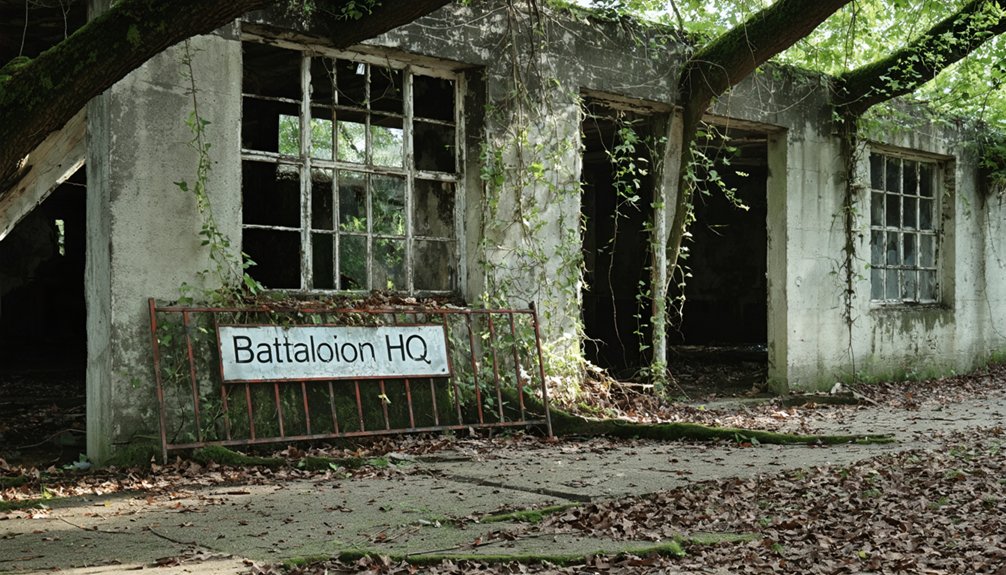
As you explore the dense Louisiana woods near Pineville today, you’ll encounter concrete foundations and support pillars from Camp Livingston, a massive WWII training facility that once covered 47,000 acres.
Nature has steadily reclaimed the former military installation since its 1946 deactivation, though you can still trace the camp’s grid layout and locate remnants of warehouses, swimming pools, and other structures through the vegetation. The site’s extensive infrastructure included 234 latrines and numerous other buildings during its operational years.
The site’s deteriorating condition poses urgent preservation challenges for this significant piece of Louisiana’s military heritage, where over 500,000 soldiers trained during World War II. After the Pearl Harbor attacks, the camp was partially converted to hold approximately 1,100 Japanese internees, including immigrants and one captured POW.
Hidden Training Grounds Revealed
Deep within Louisiana’s dense woods and swamps lie the hidden remnants of Camp Livingston, a massive World War II infantry training center that once sprawled across 18,000 acres between Rapides and Grant Parishes.
Through military archaeology and satellite imagery, you’ll discover grid-like roads, scattered foundations, and two distinct strings of box-like structures emerging from the overgrowth.
Originally established as Camp Tioga in 1940, this training ground equipped hundreds of thousands of soldiers, including four infantry divisions and a pioneering African American aviation squadron.
You’ll find traces of the camp’s extensive facilities: a 9-acre hospital complex connected by 2 miles of corridors, the distinctive “Snake House” for wildlife training, and the sprawling Breezy Hill Artillery Range where troops mastered weapons from small arms to mortars.
Nature Reclaims Military Past
Time and nature have steadily transformed Camp Livingston’s military infrastructure into a mystifying forest landscape.
You’ll find concrete roads, foundations, and swimming pools now obscured by Louisiana’s dense pine forests and persistent underbrush. The natural reclamation of this once-sprawling 18,000-acre military installation showcases nature’s power to reclaim human-made structures.
Where thousands of WWII soldiers once trained, wildlife now thrives among the ruins. Hurricane damage, fungal decay, and relentless weathering continue breaking down the remaining structures.
The historical significance of this site – from its role as a major infantry training ground to its darker chapter housing Japanese American internees and POWs – lies hidden beneath an ancient forest canopy.
Without careful exploration, you’d never know these woods once echoed with military drills and wartime activities.
Louisiana Heritage Under Threat
Though once a sprawling military installation essential to America’s WWII efforts, Camp Livingston‘s remaining ruins now face mounting threats from urban expansion, logging operations, and natural erosion.
You’ll find only scattered concrete foundations and weathered roads where 18,000 workers once built this massive training facility in 1940.
The camp’s historical significance extends beyond military training – it served as an internment site for Japanese Americans and housed German, Italian, and Japanese POWs during the war.
Today, the orderly grid of cement pathways still cuts through Louisiana’s dense pine forest, but there’s little effort toward heritage preservation.
Without proper protection, you’re witnessing the gradual disappearance of an important WWII landmark that trained thousands of American soldiers and held both allies and enemies within its bounds.
Fort Hancock: Sandy Hook’s Military Sentinel
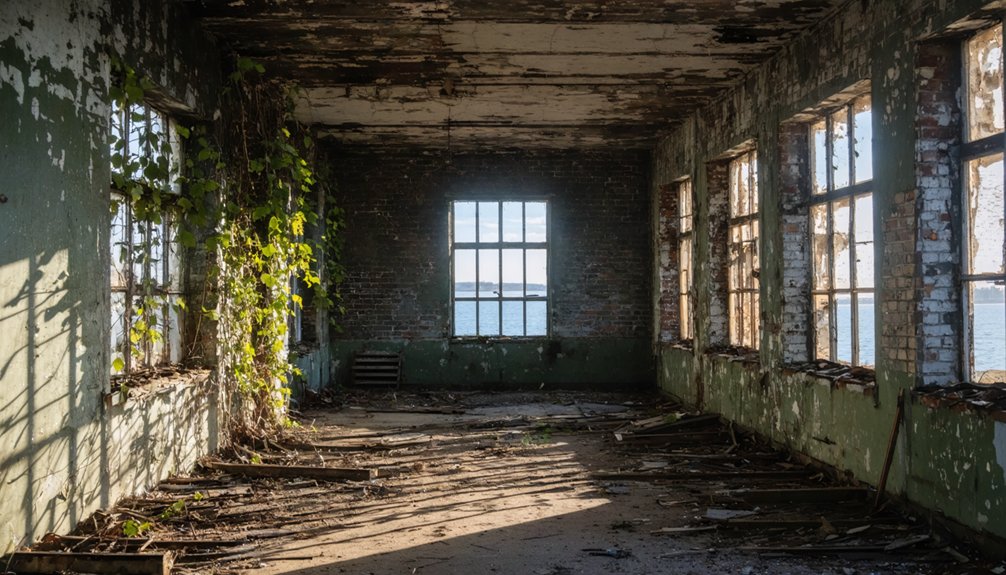
Fort Hancock’s legacy on Sandy Hook began in 1806 when Richard Hartshorne transferred most of the northern peninsula to the Federal Government.
The fort’s history reflects evolving military architecture, from the wooden Fort Gates built in 1813 to an ambitious granite fortification started in 1859. You’ll find that construction halted in 1870 when masonry forts proved vulnerable to rifled guns.
In 1874, the Sandy Hook Proving Ground emerged as America’s first official weapons testing facility, revolutionizing artillery development until 1919.
The site reached its peak during World War II, housing over 5,000 troops and featuring advanced installations like Battery Lewis with its massive 16-inch guns.
Today, you can explore the preserved ruins, including Cold War-era Nike missile sites, as part of the Gateway National Recreation Area.
Camp Adair’s Agricultural Transformation in Oregon
While Sandy Hook’s military legacy endures on the East Coast, a remarkable transformation unfolded in Oregon’s Willamette Valley.
After World War II, Camp Adair‘s massive 65,000-acre footprint underwent extensive land repurposing. In 1945, you’d have witnessed 45,000 acres declared surplus, with original landowners given first rights to repurchase their former properties.
The agricultural legacy continued as soldiers assisted local farmers with harvests and flood rescues before the camp’s closure.
The Impact of Weather on Military Infrastructure
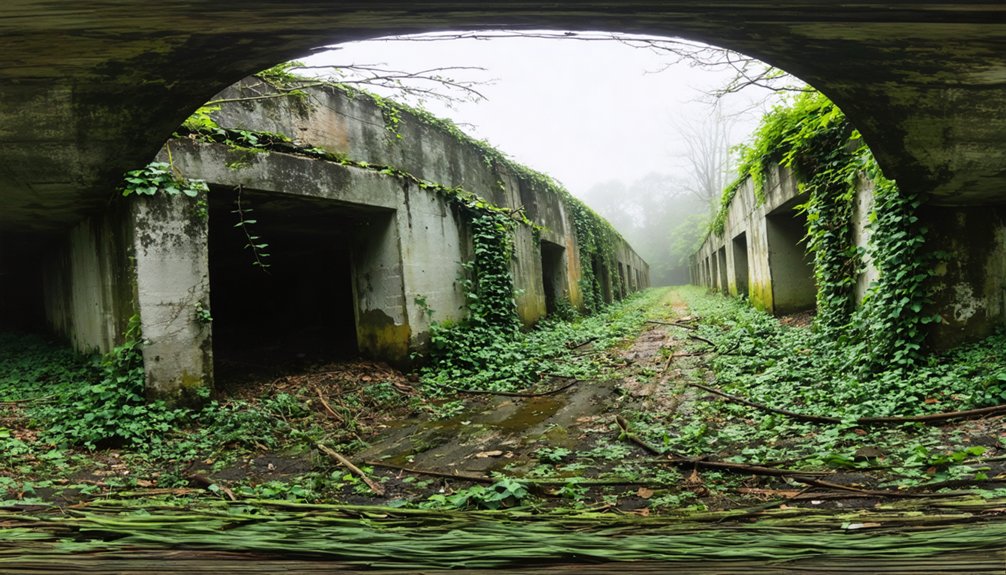
You’ll find widespread structural deterioration at abandoned military training camps, where coastal erosion has accelerated the collapse of concrete foundations and protective barriers.
The extreme temperature fluctuations between seasons have caused significant cracking and spalling of building materials, particularly in camps located in regions with harsh freeze-thaw cycles.
Exposure to decades of rain, snow, and humidity has left metal components severely rusted and wooden structures heavily decayed, creating a visible timeline of weather’s destructive impact on military infrastructure.
Coastal Erosion Threats
As coastal regions face increasing environmental pressures, America’s military training facilities have become particularly vulnerable to shoreline erosion and flooding impacts.
You’ll find that 45% of U.S. military sites within 2 kilometers of coastlines report flooding issues, with some locations losing up to 12 feet of shoreline in just four years. This erosion directly threatens critical infrastructure like piers, airfields, and supply hubs.
To combat these challenges, military installations are implementing coastal resilience strategies through both natural and structural solutions.
You’ll see bases using sills, riprap, and wetland restoration, while others opt for beach nourishment and dune reconstruction.
Military infrastructure adaptation now includes consolidating vulnerable assets on higher ground and installing protective structures like seawalls and storm surge barriers, especially in high-risk areas along the East Coast.
Extreme Temperature Challenges
Due to rising global temperatures, military training facilities across the United States face unprecedented challenges from extreme heat conditions.
You’ll find abandoned training grounds where extreme heat has caused infrastructure damage, with buckled runways and deteriorating buildings that couldn’t withstand the relentless temperatures.
Between 2008-2018, heat-related incidents claimed at least 17 military lives, severely impacting military readiness.
- Training camps in Florida and the Southwest have suffered the most severe damage, with numerous facilities requiring extensive repairs or abandonment.
- Black flag conditions have forced the closure of outdoor training areas, leaving once-bustling facilities empty.
- Power grid failures from overwhelmed cooling systems have rendered many training installations inoperable.
These temperature challenges continue to reshape military training landscapes, leaving behind stark reminders of how climate change affects military infrastructure.
Rust and Decay Patterns
Weather conditions relentlessly assault abandoned military training facilities, triggering widespread rust and decay patterns that compromise structural integrity.
You’ll notice distinctive rust patterns spreading across metal structures, particularly severe in coastal locations where salt spray accelerates deterioration. The decay processes intensify during freeze-thaw cycles, cracking protective coatings and exposing fresh metal surfaces to oxidation.
In these forgotten compounds, you’ll find how deferred maintenance has allowed minor issues to cascade into major structural concerns.
Water infiltration through compromised seals feeds continuous cycles of corrosion, while saturated grounds undermine foundations. Load-bearing elements weaken progressively as rust consumes metal connectors and support systems.
These deterioration patterns ultimately transform once-robust military infrastructure into hazardous structures prone to collapse during extreme weather events.
Preservation Challenges at Historic Training Sites
Historic military training sites across the United States face mounting preservation challenges that threaten both their structural integrity and ecological value.
You’ll find funding obstacles regularly stall critical restoration work, while ecological balance hangs in precarious tension between natural succession and conservation needs.
Without intervention, these sites deteriorate as forests encroach on former training grounds and structures crumble under weather exposure.
- Buildings suffer from advancing decay, with wooden elements rotting and metal components corroding beyond repair.
- Natural succession threatens rare species habitat as open areas transform into dense woodland.
- Limited financial resources force difficult choices between preserving historic architecture and maintaining ecological systems.
To combat these challenges, you’ll need coordinated efforts between government agencies, local communities, and preservation groups, implementing targeted management strategies that protect both historical features and environmental assets.
From Combat Training to Public Recreation Areas
Despite preservation hurdles, many abandoned military training camps have found new life as vibrant public recreation areas across the United States.
You’ll find prime examples like the Presidio of San Francisco and Fort Ord, where former combat training grounds now offer extensive trail networks for hiking, biking, and horseback riding. These transformed spaces prioritize community engagement through festivals, outdoor activities, and cultural events.
Historical education remains a cornerstone of these conversions.
You’ll discover interpretive trails, museums, and visitor centers that chronicle each site’s military heritage. Places like Prince William Forest Park and Camp Claiborne feature informative markers and guided tours that connect you to their WWII past.
Through integration into national and state park systems, these former military grounds now serve as dynamic spaces where you can freely explore both nature and history.
Environmental Conservation at Former Military Bases
While military training camps once posed significant environmental challenges, these sites have become focal points for ambitious conservation initiatives across the United States.
Through environmental restoration efforts, you’ll find former training grounds transformed into thriving wildlife habitats. Restoration Advisory Boards work alongside community volunteers to implement biodiversity conservation strategies, turning contaminated spaces into protected ecosystems.
Military training grounds are being reborn as vibrant wildlife sanctuaries through dedicated restoration work by advisory boards and local communities.
- The Army now manages over 82,000 archaeological sites and supports native species protection through partnerships with local experts.
- You’ll discover sustainable restoration techniques being used to prevent further environmental deterioration.
- Cleanup programs actively address soil and groundwater contamination, with specific focus on PFAS chemicals and TCE removal.
These restoration efforts showcase how military ruins can evolve from environmental hazards into essential conservation areas.
Frequently Asked Questions
What Personal Items Have Been Discovered at These Abandoned Military Camps?
Like echoes from the past, you’ll find historical artifacts from soldiers’ lives: uniform buttons, dog tags, religious tokens, personal mementos like watches and photos, plus equipment including mess kits and writing tools.
How Dangerous Are Unexploded Ordnance at These Former Training Sites?
You’ll face severe unexploded ordnance risks at former training sites, including deadly explosions and toxic contamination. Stay on marked trails and heed warning signs – these munitions remain dangerous for decades.
Are There Any Ghost Stories Associated With These Abandoned Camps?
Like Gatsby’s green light, you’ll find ghost sightings at camps nationwide. Fort Ord’s haunted history includes spectral soldiers in decaying barracks, while Camp Livingston’s visitors report shadowy figures and unexplained voices.
Can Metal Detectors Be Legally Used at These Military Sites?
You can’t legally metal detect at abandoned military camps without proper permits. These sites are protected by federal and state regulations due to their historical significance and archaeological value.
Which Abandoned Military Camps Still Contain Classified Underground Facilities?
You can’t verify which abandoned camps contain active classified access, as military secrets about underground facilities remain protected. Most publicly known sites like Raven Rock are now declassified or decommissioned.
References
- https://www.loveexploring.com/gallerylist/233478/americas-eeriest-abandoned-military-sites
- https://en.wikipedia.org/wiki/List_of_former_United_States_Army_installations
- https://www.youtube.com/watch?v=U5aa3wWMu_Y
- https://www.youtube.com/watch?v=Dso_vPKcsuE
- https://www.youtube.com/watch?v=pcX5nv0XhCA
- https://mybaseguide.com/abandoned-military-bases
- https://www.youtube.com/watch?v=MYe6MXx_3rE
- https://thedesigninspiration.com/news/facts/these-15-abandoned-military-bases-will-leave-you-speechless/
- https://abandonedwonders.com/tag/abandoned-military-base/
- https://www.epa.gov/fedfacts/base-realignment-and-closure-act-sites
